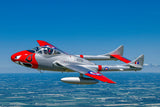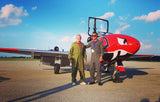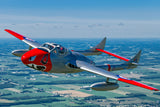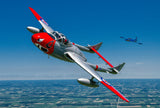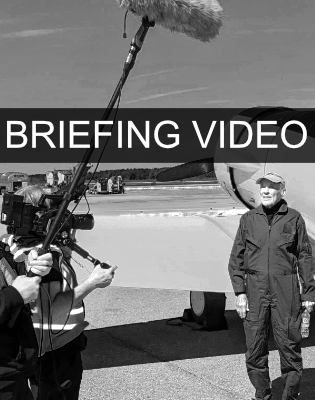Aircraft Type History
 The De Havilland Vampire was developed in 1943 in Britain and just missed seeing action with the Royal Air Force in WWII. It is a descendant of the De Havilland Mosquito and as such shares some interesting structural aspects. As the Vampire was developed and first flown during wartime, De Havilland decided to construct the fuselage out of plywood, a non-essential war material. The company had already enjoyed terrific success with the Mosquito, known as the ‘Wooden Wonder’ and used the same plywood layering process to build the Vampire’s fuselage. The main difference in construction was that the remainder of the Vampire (wings, tail booms and engine compartment) was made of metal. The Vampire was developed with twin tail booms (somewhat resembling a P-38 Lightning) for a very specific reason; De Havilland wanted to produce an aircraft using just one jet engine. Both combat jets produced to that point, the ME262 and the Gloster Meteor, had two engines. A plane with a single-engine would be lighter and use less fuel. However, the existing jet engine of the day did not have a large amount of thrust, so a short tailpipe was needed to take maximum advantage of the modest thrust. The engine was mounted at the back of the fuselage and the short tailpipe necessitated twin booms for appropriate tail support and to keep it out of the way of the thrust. This successful design resulted in the first operational jet fighter with one engine.
The De Havilland Vampire was developed in 1943 in Britain and just missed seeing action with the Royal Air Force in WWII. It is a descendant of the De Havilland Mosquito and as such shares some interesting structural aspects. As the Vampire was developed and first flown during wartime, De Havilland decided to construct the fuselage out of plywood, a non-essential war material. The company had already enjoyed terrific success with the Mosquito, known as the ‘Wooden Wonder’ and used the same plywood layering process to build the Vampire’s fuselage. The main difference in construction was that the remainder of the Vampire (wings, tail booms and engine compartment) was made of metal. The Vampire was developed with twin tail booms (somewhat resembling a P-38 Lightning) for a very specific reason; De Havilland wanted to produce an aircraft using just one jet engine. Both combat jets produced to that point, the ME262 and the Gloster Meteor, had two engines. A plane with a single-engine would be lighter and use less fuel. However, the existing jet engine of the day did not have a large amount of thrust, so a short tailpipe was needed to take maximum advantage of the modest thrust. The engine was mounted at the back of the fuselage and the short tailpipe necessitated twin booms for appropriate tail support and to keep it out of the way of the thrust. This successful design resulted in the first operational jet fighter with one engine.
 Although the Vampire did not see action in the War, it immediately became Great Britain’s front line operational jet fighter and had much success in this role. It was the first jet aircraft to cross the Atlantic Ocean and also the first jet to land and take off from an aircraft carrier. The T55 trainer variant was the first jet fighter trainer to have the pilot and student sit side by side. The cockpits of the early versions interestingly resembled the Mosquito, as the entire cockpit was the same. Different derivatives of the Vampire served with the Royal Air Force for 20 years, finally being retired in 1966. In 1948, the Vampire also earned the distinction of being the first operational jet aircraft with the Royal Canadian Air Force. It was flown for eight years when the last squadrons’ planes were replaced with Sabres. The Blue Devils became the first Canadian Air Force jet acrobatic team in 1949, flying Vampires and thrilling crowds across the country. The Vampire also holds the distinction of being the last British-built aircraft purchased by the RCAF. Over 3,200 Vampires were built and they served with a wide variety of nations worldwide.
Although the Vampire did not see action in the War, it immediately became Great Britain’s front line operational jet fighter and had much success in this role. It was the first jet aircraft to cross the Atlantic Ocean and also the first jet to land and take off from an aircraft carrier. The T55 trainer variant was the first jet fighter trainer to have the pilot and student sit side by side. The cockpits of the early versions interestingly resembled the Mosquito, as the entire cockpit was the same. Different derivatives of the Vampire served with the Royal Air Force for 20 years, finally being retired in 1966. In 1948, the Vampire also earned the distinction of being the first operational jet aircraft with the Royal Canadian Air Force. It was flown for eight years when the last squadrons’ planes were replaced with Sabres. The Blue Devils became the first Canadian Air Force jet acrobatic team in 1949, flying Vampires and thrilling crowds across the country. The Vampire also holds the distinction of being the last British-built aircraft purchased by the RCAF. Over 3,200 Vampires were built and they served with a wide variety of nations worldwide.
Our Vampire’s History
C-FJRH is a DH-115 T55 trainer that was built in 1958 under licence in Switzerland by Eidgenössisches Flugzeugwerk Emmen, for the Swiss Air Force as U-1213 (airframe no. 973). She was originally armed with four 20mm Hispano cannons and was used as an advanced trainer. DH-115 T55 Vampires served in the Swiss Air Force from 1953 to 1990. U-1213 was struck off service in 1990, sold at auction in Sion in March of 1991 and issued US civil registration N935HW, being purchased by a private company in Paoli, Pennsylvania. U-1213 and another surplus Vampire, U-1220 were then ferried across the Atlantic, a remarkable adventure detailed by pilot Paul McMinn in his entertaining book, “Vampires & Goblins Across the Atlantic, A Ferry Tale”. As told in the book, the Vampires were first equipped with de Havilland Venom drop tanks (larger than the standard Vampire ones) and then flown to Cranfield, England to have several modifications made, most notably including new radios and installation of batteries for self starting.
The Atlantic transit began on September 16, 1991, and included 16 stops at a variety of airfields in Scotland, the Faroe Islands, Iceland, Greenland, North Eastern Canada and the Eastern United States, finally arriving in Coatesville, Pennsylvania 6 days later. The transit was carefully planned to have minimal time over open water while retaining as much fuel as possible. Some of the airfields used were gravel strips and military installations. Both Vampires made the trip in excellent shape, however due to pilot error U-1220 lost its canopy on takeoff from Wabush, Labrador, causing a quick shutdown and immediate repairs.
Once in Coatesville, N935HW remained in the same private hands until September of 2008, when it was acquired by Dave Sutton of Red Star Aviation in Hackettstown, New Jersey and registered as N835HW. The Vampire was eventually lodged at the Quonset Air Museum in Rhode Island, where it came to the attention of Canadian aviation enthusiast Derek Hammond, chief officer of what would become Waterloo Warbirds. Hammond, owner of a Canadair Silver Star T-33, had been looking to purchase another two-seat jet such as a BAC Strikemaster or Aero Vodochody L-39. Discussions ensued and Vampire N835HW was acquired in 2010. Hammond and aviation technician Andrej Janik flew to Rhode Island in late October to ferry the jet to their hangers at the Region of Waterloo International Airport. The flight was not without incident, as the nose wheel departed the craft upon landing in Rochester, New York, prior to their border crossing into Canada, an accident caused by previous inappropriate maintenance. This caused a delay in the delivery of the jet, resulting in a plethora of paperwork needing to be re-issued.
 Once at its new home, N835HW was issued Canadian registration C-FJRH and remains in the Hammond family’s care to this date. The aircraft was grounded for the next four years as it received significant maintenance and updating of mechanics, systems and avionics. This work was greatly assisted by relationships built with other Vampire operators, including the Vampire Preservation Group in England, the Temora Aviation Museum in Australia, the Norwegian Air Force Historical Squadron in Norway and the nearby Canadian Warplane Heritage Museum, located in Hamilton, Ontario. C-FJRH finally returned to the air in late 2014, newly marked as a Royal Canadian Air Force jet and has become a centrepiece of the Waterloo Warbirds’ fleet.
Once at its new home, N835HW was issued Canadian registration C-FJRH and remains in the Hammond family’s care to this date. The aircraft was grounded for the next four years as it received significant maintenance and updating of mechanics, systems and avionics. This work was greatly assisted by relationships built with other Vampire operators, including the Vampire Preservation Group in England, the Temora Aviation Museum in Australia, the Norwegian Air Force Historical Squadron in Norway and the nearby Canadian Warplane Heritage Museum, located in Hamilton, Ontario. C-FJRH finally returned to the air in late 2014, newly marked as a Royal Canadian Air Force jet and has become a centrepiece of the Waterloo Warbirds’ fleet.
 In late 2017, it was noted that the fabric covering the Vampire’s fuselage was starting to deteriorate. Sometime after it left the Swiss Air Force, one of the private owners had repainted the aircraft using what appeared to be automotive paint. Although glossy in appearance, this caused an eventual drying out of the original Irish linen (or Swiss equivalent) fabric and it had started cracking and coming off the fuselage in chunks. It was determined that the old fabric had to be removed and replaced. In late November of 2017, a team of volunteer members of the Waterloo Warbirds, supported by the aviation technicians of Flight Line Services based at the Region of Waterloo International Airport, began the process of stripping and recovering C-FJRH. The process was uncomplicated, but stressful. Once all fittings were removed from the fuselage, the fabric was removed using a heat gun and composite wedge. This was a very tricky endeavor; once the fabric was sufficiently heated to melt the dope holding it to the wood, there was about a 10 second gap to pull it off the wooden fuselage before the heat gun actually set the fabric, dope and paint afire. A fire extinguisher (thankfully, not needed), was always located near the work in progress.
In late 2017, it was noted that the fabric covering the Vampire’s fuselage was starting to deteriorate. Sometime after it left the Swiss Air Force, one of the private owners had repainted the aircraft using what appeared to be automotive paint. Although glossy in appearance, this caused an eventual drying out of the original Irish linen (or Swiss equivalent) fabric and it had started cracking and coming off the fuselage in chunks. It was determined that the old fabric had to be removed and replaced. In late November of 2017, a team of volunteer members of the Waterloo Warbirds, supported by the aviation technicians of Flight Line Services based at the Region of Waterloo International Airport, began the process of stripping and recovering C-FJRH. The process was uncomplicated, but stressful. Once all fittings were removed from the fuselage, the fabric was removed using a heat gun and composite wedge. This was a very tricky endeavor; once the fabric was sufficiently heated to melt the dope holding it to the wood, there was about a 10 second gap to pull it off the wooden fuselage before the heat gun actually set the fabric, dope and paint afire. A fire extinguisher (thankfully, not needed), was always located near the work in progress.
 Once totally stripped, the wooden fuselage was inspected and revealed very few areas in need of repair, the wood still being strong after nearly 60 years. After these slight repairs were made, the entire fuselage was covered in aviation grade varnish, and starting with the wooden gun bay doors, recovered using modern dope and ceconite fabric. For the volunteers, the application of the fabric was a case of learning on the job, especially tricky on the fuselage itself due to its many compound curves. Fortunately, any wrinkles in the fabric responded well to an aviation iron and the final result was satisfactory. After applying several more coats of standard dope, two coats of silver nitrate dope were applied to assist in UV protection. The entire fuselage was then finished with proper aviation paint and all parts reassembled. Prior to this work, C-FJRH had worn basic RCAF markings. Consideration was given to having the newly refreshed bird marked in period accurate, but also interesting livery.
Once totally stripped, the wooden fuselage was inspected and revealed very few areas in need of repair, the wood still being strong after nearly 60 years. After these slight repairs were made, the entire fuselage was covered in aviation grade varnish, and starting with the wooden gun bay doors, recovered using modern dope and ceconite fabric. For the volunteers, the application of the fabric was a case of learning on the job, especially tricky on the fuselage itself due to its many compound curves. Fortunately, any wrinkles in the fabric responded well to an aviation iron and the final result was satisfactory. After applying several more coats of standard dope, two coats of silver nitrate dope were applied to assist in UV protection. The entire fuselage was then finished with proper aviation paint and all parts reassembled. Prior to this work, C-FJRH had worn basic RCAF markings. Consideration was given to having the newly refreshed bird marked in period accurate, but also interesting livery.
The RCAF flew Vampires with ten different squadrons across Canada, both regular service and ‘auxiliary’ squadrons, mainly comprised of discharged WWII veterans working during the week and flying on their time off, a practice used successfully in other countries. One particular RCAF squadron was 442, the ‘City of Vancouver’ Auxiliary Fighter Squadron, stationed at Sea Island, the current location of Vancouver International Airport. In the early 1950’s, 442 Squadron had several of their Vampire jets painted with red and black vampire faces. The colourful artwork was inspired by local indigenous culture. One jet painted with the original type of artwork exists today, preserved at the Canadian Museum of Flight in Langley, British Columbia. In early 2018, artwork was created in homage to these unique jets and was applied via vinyl wrap to the nose of C-FJRH. Other markings are being considered to pay tribute to those who flew her and they will be added in due course. Vampire C-FJRH is one of very few T55 Vampires still flying.

Your Flight Experience Day
The Technical Stuff
General Characteristics
- Crew: 1/2
- Powerplant: 3,500 lbst DH Goblin 35
- Span: 38 ft 0 in
- Maximum Weight: 11,150 lb
- Capacity & Armament: Two crew, four 20mm Hispano cannon, provision for underwing drop tanks
- Maximum Speed: 538 mph
- Range: 840 miles






